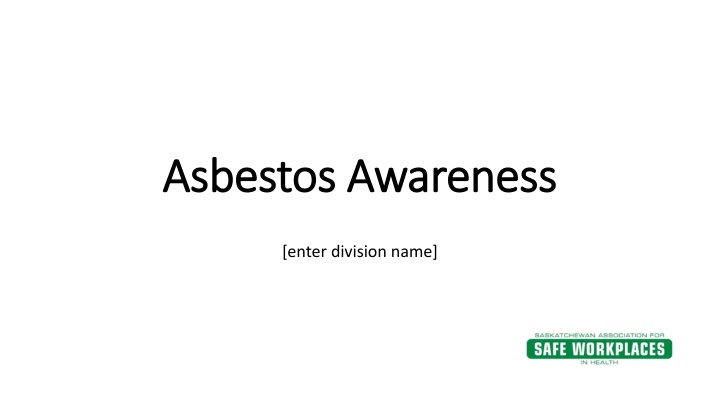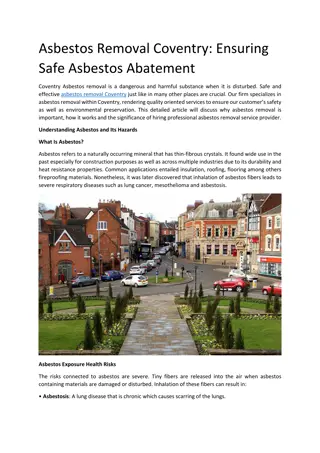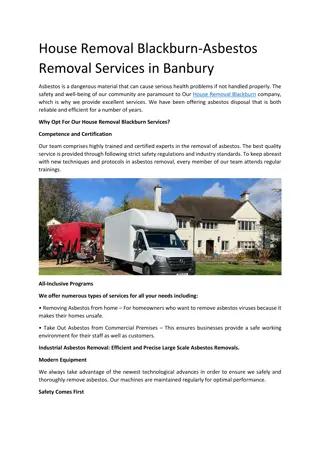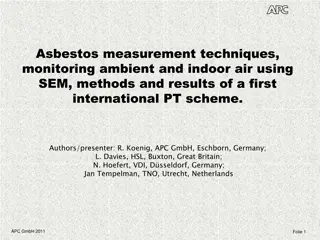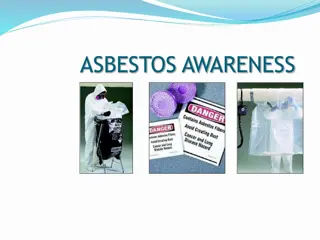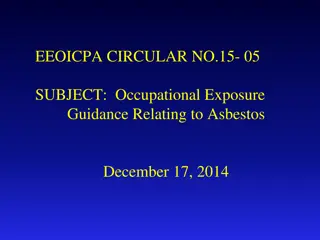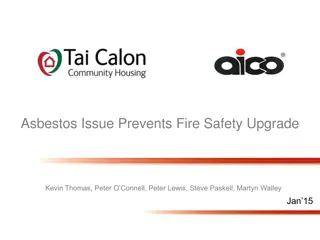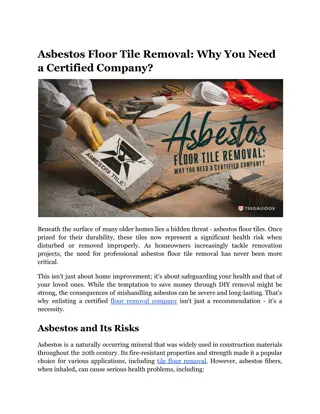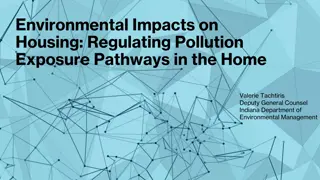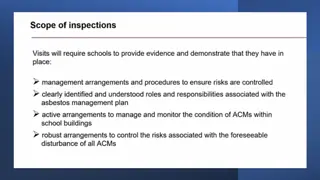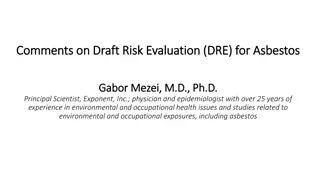Asbestos Awareness
Asbestos is a serious health hazard found in buildings today. This presentation aims to familiarize staff with asbestos, its health effects, and how to recognize asbestos materials. It does not qualify workers to handle asbestos directly. Learn about types of asbestos, how it breaks into tiny fibers, its insulating properties, and products containing asbestos. Essential information for maintaining a safe work environment.
Download Presentation

Please find below an Image/Link to download the presentation.
The content on the website is provided AS IS for your information and personal use only. It may not be sold, licensed, or shared on other websites without obtaining consent from the author.If you encounter any issues during the download, it is possible that the publisher has removed the file from their server.
You are allowed to download the files provided on this website for personal or commercial use, subject to the condition that they are used lawfully. All files are the property of their respective owners.
The content on the website is provided AS IS for your information and personal use only. It may not be sold, licensed, or shared on other websites without obtaining consent from the author.
E N D
Presentation Transcript
Asbestos Awareness Asbestos Awareness [enter division name]
This presentation is an Asbestos Awareness presentation only. Its purpose is to familiarize staff with asbestos, health effects associated hazards and recognition of asbestos materials in [enter division name] buildings. This presentation DOES NOT qualify staff/workers to remove or work with asbestos it is only for general awareness information. In-depth training as well as worker experience is required for individuals to perform asbestos abatement.
What is asbestos? What is asbestos? The word "asbestos" comes from the Greek meaning "inextinguishable. Asbestos is a serious health hazard commonly found in our environment within our buildings today. Employees who may work in buildings that contain asbestos must know where it is found and how to avoid exposure.
Types of asbestos Types of asbestos Asbestos is composed of six different types of natural minerals: Chrysotile (white asbestos) Amosite (brown asbestos) Crocidolite (blue asbestos) Tremolite Actinolite Anthophyllite Most common types Of the six, three are used more commonly. Chrysotile is the most common, but it is not unusual to encounter Amosite, or Crocidolite as well. In many instances a single product will have a mixture of different asbestos types.
Asbestos facts Asbestos facts All types of asbestos tend to break into very tiny fibers. These individual fibers are so small they must be identified using a microscope. Some fibers may be up to 700 times smaller than a human hair. Because asbestos fibers are so small, once released into the air, they may stay suspended there for hours or even days. Asbestos fibers are also virtually indestructible. Resistant to chemicals and heat, and they are very stable in the environment. Do not evaporate into air or dissolve in water, and they are not broken down over time. Asbestos is probably the best insulator known to man. Asbestos fibrous material was regularly used in buildings until later 1990.
Asbestos containing products Asbestos containing products HSE, University of British Columbia: http://www.hse.ubc.ca/safety/asbestosmanagement/typicalusesofasbestos.html Usually asbestos is mixed with other materials to actually form the products. Floor tiles, for example, may contain only a small percentage of asbestos. Depending on what the product is, the amount of asbestos in asbestos containing materials (ACM) may vary from 1%-100%.
Classification of asbestos Classification of asbestos Friable Can be crushed between the fingers to a powered state when dry. Easily release asbestos fibers. Presents the highest hazard as minor disturbance can easily result in exposure. Non-friable Can not be damaged by hand pressure. Asbestos containing material bound in a resin matrix. Does not easily release asbestos fibers. Presents a lower hazard as disturbance requires more effort.
Asbestos exposure Asbestos exposure Asbestos removal and building renovation & demolition have the greatest exposures. Disturbing or removing insulation, roofing shingles or siding containing asbestos. If asbestos is disturbed, small fibers are released into the air. Sanding or scraping older surface treatments containing asbestos. Vinyl floor tile Roofing tar paper Spackling Sealants, paint, putty , caulking or drywall Professions that may be exposed to asbestos (including but not limited to): Carpenters Plumbers Roofers Construction workers/demolition Insulation installers Caretakers/custodial/housekeepers www.healthycanadians.gc.ca
Health effects of asbestos exposure Health effects of asbestos exposure Three common diseases linked to asbestos exposure: Mesothelioma Lung Cancer Asbestosis Asbestos-related lung diseases are the number one cause of work- related fatalities in the province of Saskatchewan. In particular, mesothelioma and other asbestos-related lung diseases were responsible for approximately 26 per cent of the 390 fatalities accepted by the Saskatchewan WCB in the last decade (2010-2019). In 2019, 47 per cent of work-related fatalities were a result of occupational diseases. The risk of injury to health caused by the inhalation of asbestos is increased by smoking. Could take 20 years for one asbestos fiber to turn into one of these deadly diseases Always protect yourself if you suspect asbestos
Health effects of asbestos exposure Health effects of asbestos exposure Everyone is exposed to asbestos at some time during their life. Low levels of asbestos are present in the air, water and soil. Most people do not become ill from their exposure. People who become ill from asbestos are usually those who are exposed to it on a regular basis, most often in a job where they work directly with the material or through substantial environmental contact. When asbestos is disturbed, it can travel through the air as very fine dust. As a result, it can enter the body through: Inhalation which is the most common route Ingestion fibers are inhaled , coughed out of the lungs in phlegm and then swallowed. From there, they can travel through the digestive system and become lodged in other organs Absorption through the skin asbestos fibers can become imbedded in the skin
Definitions Definitions Abatement - Removing all or part of the asbestos. Asbestos Control Plan - A program used to actively manage asbestos in the workplace. Includes identification, inventories and inspections of asbestos containing materials, labelling systems, emergency response, communication plan and training. Containment - An isolated system designed to effectively contain fibres within a designated area where asbestos contained materials are handled. Encapsulation - Sealing the surface of the asbestos with a product that prevents the fibres from being released. Enclosure - Physical barrier that isolates asbestos containing materials from adjacent occupied areas.
Asbestos Control Plan Asbestos Control Plan A plan shall be developed in consultation with the OHC and includes, but is not limited to: Identification of asbestos containing materials Written record, including location Must be readily available to all staff Labelling, placarding and clearing identified on a map or plan Inspection, annually be a competent person ensuring to keep a written record to provide to the OHC Communication plan Training Safe work procedures and practices [Enter division name] recognizes its responsibility to ensure the health and safety of all staff and students. The Occupational Health and Safety Regulations, 2020 Section 2-1 and Part 23 addresses asbestos. Asbestos can and must be managed in the workplace The Occupational Health and Safety Regulations, 2020 New operations, Section 2-1 and Part 23 requires notification to be given to the Labour Relations Workplace Safety Division 14 days prior to a high risk asbestos process. All asbestos related work taking place in any [enter division name] facilities must comply to the legislation. Any questions or concerns please contact the Operations Supervisor. (Division specific)
Resources Resources The Occupational Health and Safety Regulations, 2020 Section 2-1 Part 23 Saskatchewan Asbestos Abatement Manual - Government of Saskatchewan Safe Work Practices for Handling Asbestos- WorkSafe BC https://www.ccohs.ca/oshanswers/chemicals/asbestos/effects.html
